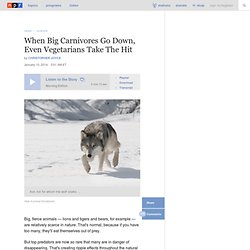

Impacts of breeder loss on social structure, reproduction and population growth in a social canid - Borg - 2014 - Journal of Animal Ecology. When Big Carnivores Go Down, Even Vegetarians Take The Hit. Hide captionAsk not for whom the wolf stalks ...

Holly Kuchera/iStockphoto Big, fierce animals — lions and tigers and bears, for example — are relatively scarce in nature. That's normal, because if you have too many, they'll eat themselves out of prey. But top predators are now so rare that many are in danger of disappearing. That's creating ripple effects throughout the natural world that scientists are still trying to figure out. What they're exploring is ecology — the interplay of animals and plants in nature. "We're dealing with the most complicated systems in the universe, and we hardly even know what the moving parts are," says Rolf Peterson, a research ecologist at Michigan Tech. Peterson studies large carnivores, and is among the world's top wolf experts. Take cougars and wolves for example. Carnivore biologist William Ripple, from Oregon State University, says even streams are affected. "The stream actually changes course," says Ripple.
SteveClever/iStockphoto. Ice Age Wolf Skull Fragment Brought to Iowa Hospital. Ice age wolf skull: A hospital in western Iowa said a piece of a purported 10,000-year-old dire wolf skull was brought to their facility recently..

WHO-TV reported that a piece of the skull was sent to the Cherokee Regional Medical Center for a CT scan on Friday “Compared to a modern day gray wolf, they’re close in size. But very robust, very heavy duty built. They’re chasing down big Ice Age animals,” Archaeologist Jason Titcomb told the station, elaborating on the size of a dire wolf. The find in Iowa is believed to be more than 12,000 years old. “It’s going to do very minimal damage, but by doing the CT scan, we’ve got an overall picture and that picture we’ll have forever.
Titcomb told KCAU-TV that the skull was found in a quarry site that was used in the 1950s. “The data can be used by researchers to look at brain morphology, pathologies, and to have a very detailed basically picture or map of the skull itself,” he told KCAU in explaining why a CT scan should be carried out.
Tick Tactic. Why the incidence of Lyme disease in North America has grown enormously and spread geographically during the past decade.

The disease is caused by the bacterium Borrelia burgdorferi, transmitted to humans and various animal species by infected blood-sucking ticks of the genus Ixodes. It has long been assumed that Lyme disease expanded following the recovery of deer populations, major reproductive hosts for adult ticks. But ecologist Taal Levi of the University of California, Santa Cruz, and colleagues think that the cause might instead lie in the decline of a key predator of small rodents: the red fox. Destroying Nature Unleashes Infectious Diseases. Predators, Prey and Lyme Disease. Taal Levi; Yiwei WangResearchers say that when plenty of red foxes are around to eat mice, the incidence of Lyme disease seems to be lower.

But when coyotes drive out foxes, the incidence of the disease is higher, they say; coyotes eat mice but tend to spread out. Deer ticks are aptly named, in a sense; a Northeastern deer can carry over 1,000 of these ticks on its body. But as far as humans are concerned, the ticks might be more relevantly called mouse ticks. That’s because white-footed mice and other small mammals, not deer, are now known by scientists to be major carriers of Lyme disease.
Study shows deer population reducing valuable North Shore trees. Listen Story audio Mar 31, 2012 On a blustery day along the shore of Lake Superior, north of Two Harbors, forest ecologist Mark White strides through an old growth forest.

Giant white pines soar 150 feet, and stands of mature cedar trees dot the forest floor. But it's not nearly as healthy a view closer to the forest floor. White notices a tiny white pine sapling that's been munched by hungry deer. Deer, predators, and the emergence of Lyme disease. Author Affiliations Edited by William H.

Schlesinger, Cary Institute of Ecosystem Studies, Millbrook, NY, and approved May 9, 2012 (received for review March 16, 2012) Abstract Lyme disease is the most prevalent vector-borne disease in North America, and both the annual incidence and geographic range are increasing. The emergence of Lyme disease has been attributed to a century-long recovery of deer, an important reproductive host for adult ticks. Footnotes Author contributions: T.L., A.M.K., M.M., and C.C.W. designed research; T.L. performed research; T.L. analyzed data; and T.L., A.M.K., M.M., and C.C.W. wrote the paper.